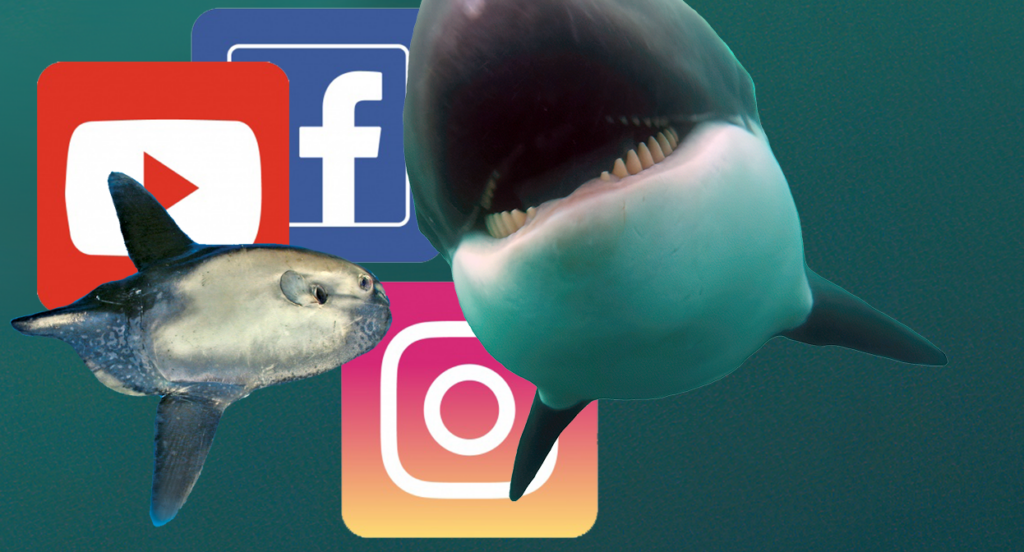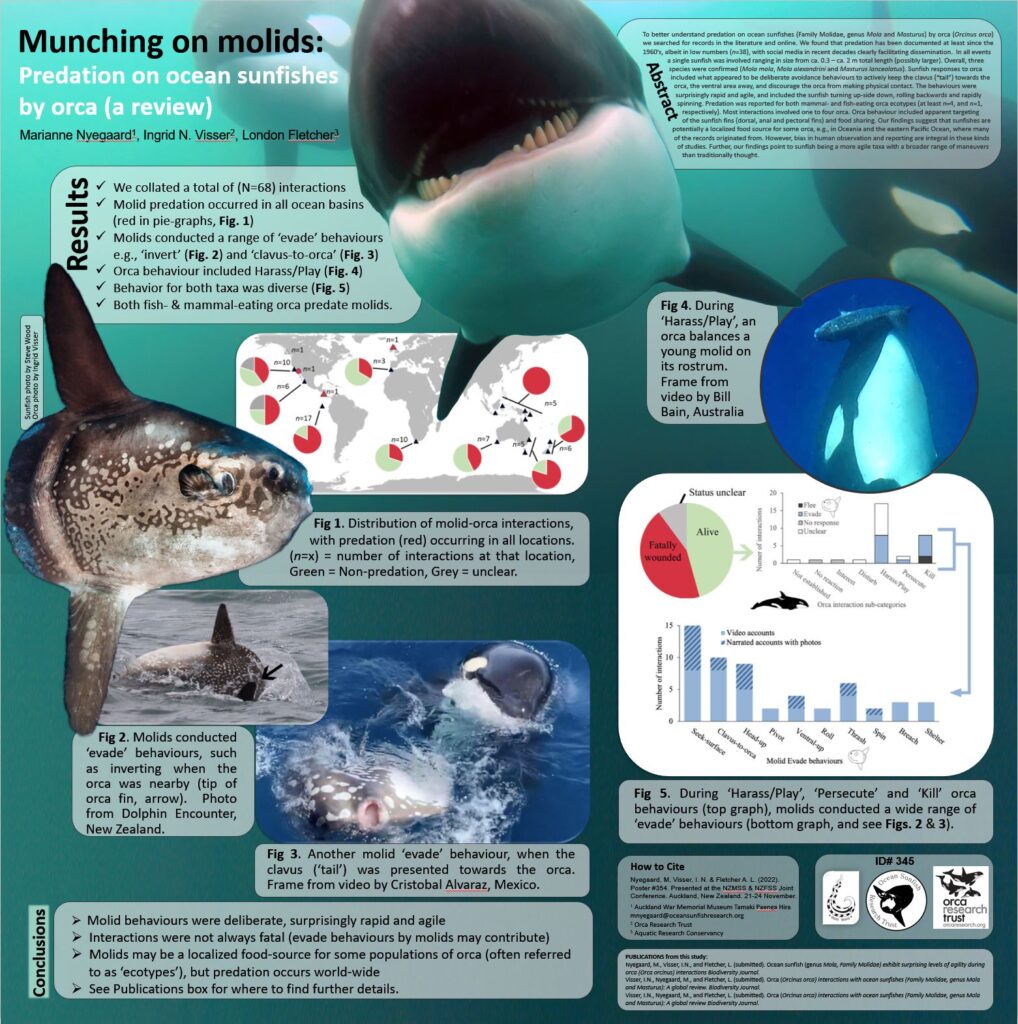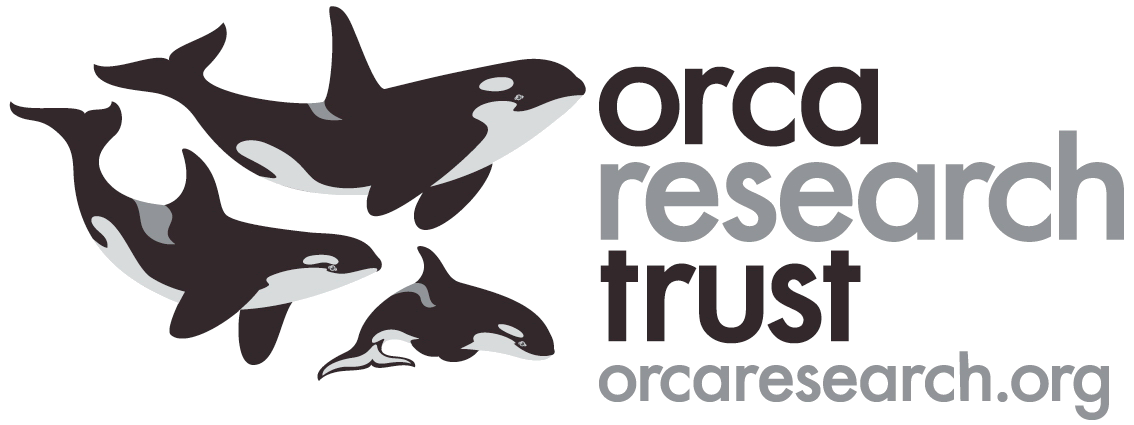Orca & Sunfishes
Orca and sunfishes are both amazing marine species. Our team produced a number of projects on interactions between these two species during 2022. Here are three of them:
Ingrid N. Visser & London A. Fletcher (2023)
First records of orca, Orcinus orca (Linnaeus, 1758) (Mammalia Cetacea), predation on sharptail ocean sunfish, Masturus lanceolatus (É. Liénard, 1840) (Pisces Molidae), with novel components of foraging behaviour discovered through social media
ABSTRACT
Foraging techniques for orca (Orcinus orca Linnaeus, 1758, killer whale, Mammalia, Cetacea) have been documented since at least the 17th century and in the last few decades a wide range of behaviours such as ‘carousel feeding’, ‘intentional stranding’ and ‘karate-chopping’ have been added to the species repertoire. During a recent global review, where records were sourced primarily through social media postings, orca interactions with the large species of ocean sunfish (Mola spp. and Masturus lanceolatus, Actinopterygii, Tetraodontiformes, Family Molidae) were collated. We discovered orca utilizing novel components of foraging strategies on these fishes. Specifically, after targeting the molids pectoral fins, the orca; (i) created a wound in the side of the molid and removed the intestines (and potentially other organs) from the still-alive molid and consumed them and (ii) then disarticulated the molid and inserted their rostrum (maxillae & mandibles) into the body cavity to extract tissue. These behaviours were documented in the South Atlantic, Oceania and the eastern Pacific Ocean, with those in the latter including what we believe to be the first confirmed predation by orca of Ma. lanceolatus. That, coupled with the novel behaviours described, may suggest an orca ecotype which has yet to be formally described, highlighting how social media can be used to document biodiversity.
Supplemental Material:
Visser & Fletcher (2022) S-1 Orca Behaviour
Visser & Fletcher (2022) S-2 Publications searched for similarities to molid predation

Marianne Nyegaard, Ingrid N. Visser, & London A. Fletcher (2023)
Ocean sunfish, genus Mola Kölreuter, 1766 (Pisces Molidae), exhibit surprising levels of agility during interactions with orca, Orcinus orca (Linnaeus, 1758) (Mammalia Delphinidae).
ABSTRACT
To better understand the interactions between orca (Orcinus orca Linnaeus, 1758, killer whale, Cetacea, Delphinidae, Mammalia) and the large species of ocean sunfish (molids, Mola spp. and Masturus lanceolatus, Tetraodontiformes, Molidae, Actinopterygii), we searched for published and unpublished records of contact between these taxa. We reviewed a total of 73 interactions between 1961 and 2022, with social media in recent decades clearly facilitating dissemination of records. The interactions were primarily clustered in hotspots in Oceania (n=17), the eastern Pacific Ocean off Central and North America (n=33), and the South Atlantic off South Africa (n=10). We assessed predation risk for the molids by distinguishing between non-predation (n=29) and predation (n=42) interactions (the status of two interactions could not be established). We document what we believe to be the first confirmed predation by orca on M. alexandrini (n=3) and we reaffirm that predation occurs on M. mola and Ma. lanceolatus. Both non-predation and predation interactions involved orca who had previously been documented feeding on fish (elasmobranch and teleost) (n=9) and mammals (pinnipeds and cetaceans) (n=19). The most common orca group size involved was a single orca (n=27) and where molid numbers could be established (n=65), all but one interaction involved a single molid. During interactions the orca exhibited cooperative hunting and food sharing and learning/teaching may have been occurring. The relatively low number of interactions found for these two sympatric and charismatic species is surprising. Explanations may include prey-selection specificity by some orca and/or reflect the opportunistic nature of human documentation. However, our findings suggest that molids are potentially a localized food source for some orca in Oceania and the eastern Pacific, as predation was documented for 65% and 58% of interactions within those regions respectively.
Supplemental Material:
Visser et al (2022) S-2_VIDEO-Orca_Molid_INTERACTIONS
Visser et al (2022) S-3_NARRATED-Orca_Molid_INTERACTIONS
Ingrid N. Visser, Marianne Nyegaard & London A. Fletcher (2023)
Orca Orcinus orca (Linnaeus, 1758) (Mammalia Cetacea) interactions with ocean sunfishes (Family Molidae, genus Mola and Masturus): A global review.
ABSTRACT
To better understand the interactions between orca (Orcinus orca Linnaeus, 1758, killer whale, Cetacea, Delphinidae, Mammalia) and the large species of ocean sunfish (molids, Mola spp. and Masturus lanceolatus, Tetraodontiformes, Molidae, Actinopterygii), we searched for published and unpublished records of contact between these taxa. We reviewed a total of 73 interactions between 1961 and 2022, with social media in recent decades clearly facilitating dissemination of records. The interactions were primarily clustered in hotspots in Oceania (n=17), the eastern Pacific Ocean off Central and North America (n=33), and the South Atlantic off South Africa (n=10). We assessed predation risk for the molids by distinguishing between non-predation (n=29) and predation (n=42) interactions (the status of two interactions could not be established). We document what we believe to be the first confirmed predation by orca on M. alexandrini (n=3) and we reaffirm that predation occurs on M. mola and Ma. lanceolatus. Both non-predation and predation interactions involved orca who had previously been documented feeding on fish (elasmobranch and teleost) (n=9) and mammals (pinnipeds and cetaceans) (n=19). The most common orca group size involved was a single orca (n=27) and where molid numbers could be established (n=65), all but one interaction involved a single molid. During interactions the orca exhibited cooperative hunting and food sharing and learning/teaching may have been occurring. The relatively low number of interactions found for these two sympatric and charismatic species is surprising. Explanations may include prey-selection specificity by some orca and/or reflect the opportunistic nature of human documentation. However, our findings suggest that molids are potentially a localized food source for some orca in Oceania and the eastern Pacific, as predation was documented for 65% and 58% of interactions within those regions respectively.
Supplemental Material:
Visser et al (2022) S-2_VIDEO-Orca_Molid_INTERACTIONS
Visser et al (2022) S-3_NARRATED-Orca_Molid_INTERACTIONS
Download Global variation in shape and size of orca (Orcinus orca) saddle patches
The New Zealand Marine Sciences Society scientific conference was held 21-24 November 2022 in Auckland, New Zealand. Dr Visser attended and co-authored this poster, which can be downloaded as a pdf by clicking on the poster image, to the left, or on the hyperlink in the title below.
ABSTRACT
To better understand predation on ocean sunfishes (Family Molidae, genus Mola and Masturus) by orca (Orcinus orca) we searched for records in the literature and online. We found that predation has been documented at least since the 1960’s, albeit in low numbers (n=38), with social media in recent decades clearly facilitating dissemination. In all events a single sunfish was involved ranging in size from ca. 0.3 – ca. 2 m total length (possibly larger). Overall three species were confirmed (Mola mola, Mola alexandrini and Masturus lanceolatus). Sunfish responses to orca included what appeared to be deliberate avoidance behaviours to actively keep the clavus (“tail”) towards the orca, the ventral area away, and discourage the orca from making physical contact. The behaviours were surprisingly rapid and agile, and included the sunfish turning up-side down, rolling backwards and rapidly spinning. Predation was reported for both mammal- and fish-eating orca ecotypes (at least n=4, and n=1, respectively). Most interactions involved one to four orca. Orca behaviour included apparent targeting of the sunfish fins (dorsal, anal and pectoral fins) and food sharing. Our findings suggest that sunfishes are potentially a localized food source for some orca, e.g., in Oceania and the eastern Pacific Ocean, where many of the records originated from. However, bias in human observation and reporting are integral in these kinds of studies. Further, our findings point to sunfish being a more agile taxa with a broader range of maneuvers than traditionally thought.


